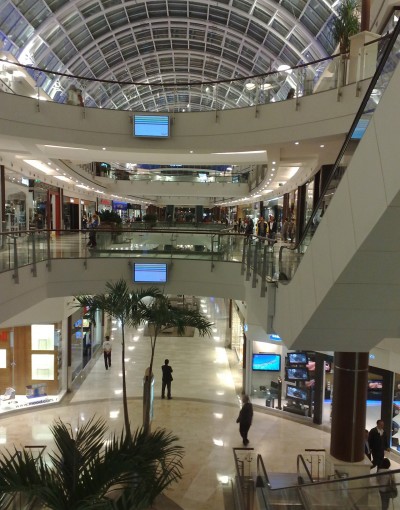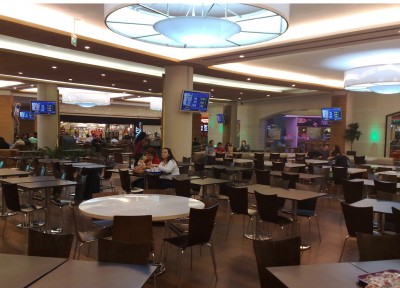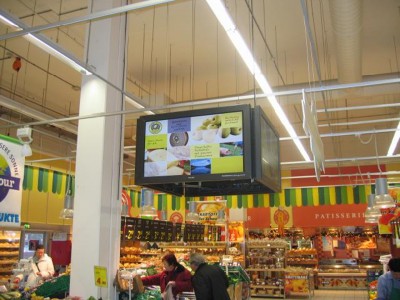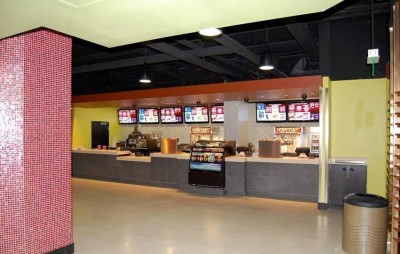Positioning digital signage media players
by all | 16 January 2014 8:30 am
 [1]
[1]Photos courtesy Minicom
By David Haar
When most digital signage networks are designed, there are early discussions about how to optimize the placement of screens to ensure the largest possible number of people will be exposed to the greatest amount of content, thus maximizing the project’s return on investment (ROI). Less understood, however, is the importance of optimizing the positioning of the network’s media players.
These information technology (IT) devices—typically small-format personal computers (PCs)—can significantly affect the total cost of ownership (TCO) for a digital signage network, particularly in terms of ongoing operations. They affect planners’ options for getting content onto the screens when they want it there.
Starting with screens
The actual placement of displays is probably the most important factor in designing a digital signage network, since any screen that cannot be properly seen by its audience will severely compromise the effectiveness of the entire network. Proper screen placement begins with answering a long list of questions and making sure requirements are met for the environment(s) that will host the digital signage network.
Screens in public areas need to be clearly visible but non-obstructive, installed in ‘dwell’ zones where people will have enough time to see them. The optimal distance from screen to viewer will also need to be determined, so the digital signage content will not appear too big or too small. Additionally, safety factors must be taken into consideration.
On top of all these factors, a number of natural and/or manmade barriers to screen placement will need to be overcome before the network can be installed. These barriers include security cameras, glare from sunlight and long distances to power sources, among others.
Only by successfully meeting all of these placement challenges can a digital signage network design facilitate optimal screen viewing and provide the best results.
Mission-critical media
Compared to the displays, media players would seem to support a much wider range of placement options. Since they do not need to be seen by the public, they can be placed almost anywhere, including both public and private zones.
That said, media players have their own set of placement requirements, which are at least as rigorous as those governing the installation of screens. While issues with screen placement mainly affect the effectiveness of message delivery and ROI, issues with media player placement are more likely to affect TCO.
The reason media players play such a significant role in digital signage networks is because they provide the content that appears to the audience. Next to the displays, they are the most mission-critical components of digital signage infrastructure.
Common scenarios
For most of today’s existing networks, the designers and/or operators have chosen one of three scenarios for media player placement:
- Integrated into the screen, using player-on-chip, open pluggable specification (OPS) or other internal interface technology.
- Mounted externally to the screen.
- Located away from the screen, such as in a data closet or at a remote facility.
Each of these options works differently and will have different repercussions in terms of the reliability, accessibility and security of the media players, which in turn will affect the TCO of the digital signage network.
 [2]
[2]Screen positioning is arguably the most important factor in designing a digital signage network, but media players are also mission-critical.
In either of the first two scenarios, i.e. with media players placed at or in the screens, the content is most commonly delivered via Internet Protocol (IP) over the network and transmitted directly to the display device. As the media players are in the public space with the screens and thus prone to ambient damage, they potentially expose the network’s owner-operator to increased costs to maintain reliability and functionality.
In the third scenario, media players are placed in ‘back rooms’ and media signal extension and distribution equipment is used to deliver the content, usually over a Category 5 (Cat5) or 6 (Cat6) cable, to a receiving device mounted at the screen. Depending on the specific technology used for this purpose, these distances can range from a few meters to a kilometre or more.
The question when designing and building out a digital signage network, then, is how to determine if it is best to position the media players at the screens or in a back room. There are advantages and disadvantages to each option.
Player at screen
The ‘player at screen’ options are suitable for digital signage applications where the screens are easily accessible and/or where the back room is either too difficult to access, perhaps due to IT security concerns, or too easy to access by unauthorized personnel, thus putting the hardware at risk. The existing network infrastructure can be used to transmit content from one central player to the multiple players at the screen locations.
Compared to other options, ‘player at screen’ applications use less hardware, simplify setup and reduce installation costs.
There are a few fundamental challenges with ‘player at screen’ scenarios that need to be addressed in the planning process. As mentioned, the devices are in public spaces and therefore may be exposed to unfriendly environmental conditions, including everything from heat and cold to dust and dirt. These conditions may have serious repercussions by shortening the players’ average time between failures and thus increasing TCO.
 [3]
[3]When media players are attached to screens, they are often either positioned high out of easy reach.
Also, since the players are attached to the screens, they are often either positioned high out of easy reach or sandwiched between a screen and a wall, so servicing and upgrading them can prove challenging. It may be necessary to remove the screen from the wall and/or remove its mounts and brackets to reach the player, which in many retail environments would be problematic.
If a player malfunctions in the middle of the day, for example, the digital signage network operator may not be permitted to bring in a repair professional and a ladder for an hour or two to fix the hardware right in front of the store’s customers—nor to close the store to service it. Instead, he/she would most likely need to wait until non-opening hours, such as early in the morning, late at night or on the weekend.
Also, depending on the nature of the location, placing media players in a public space can expose them to security problems, including vandalism and theft. This may necessitate adding more security measures to protect the investment than would otherwise be needed if the players were installed somewhere else with better existing protection.
The back room
As mentioned, using media signal extension and distribution equipment enables media players to be installed far away from the public space, in an environmentally controlled room, where they will be more secure.
So long as the appropriate employees can enter this room, the challenges of accessibility are significantly reduced. There is no need to disturb a shop’s customers for hardware repairs. Storage is easier. And with all of the screens’ media players mounted on the same rack, upgrades and servicing can be accomplished within minutes, rather than hours.
 [4]
[4]Sandwiching a media player between a screen and a wall can also prove problematic for regular servicing and upgrades.
When a problem crops up, it can be fixed immediately. Work can be carried out during regular daytime hours, rather than waiting until nighttime when service costs may be doubled or tripled.
There should also be less frequent need for servicing, with the hardware investment protected. The temperature-controlled room will prevent the players from overheating and keep them dust-free, so they will not break down as quickly as players located at screens.
Further, in many cases, the installation charges are the same, because the same cabling that would be used to bring data to a screen-mounted player can be used for media signal extension and distribution purposes.
As the audiovisual (AV) industry continues to transition from analogue to digital data distribution systems, however, the technology choices can become difficult. There are three basic choices for media signal extension today:
- Older analogue Video Graphics Array (VGA) hardware, which tend to be more cable-friendly than newer digital options and can cover longer distances.
- High-definition Base T (HDBaseT) connectivity, which uses a specific chip set to enable the transmission of uncompressed HD video, stereo audio, bi-directional RS-232 serial binary single-ended data and control signals, 100-MB Ethernet signals, some control signals and electrical power, all through the same single cable. HDBaseT extenders require shielded Cat6 cable for optimal performance and are limited to 330 m (100 ft) in distance. A newer version of the chip set allows for longer distances, but only by eliminating the control signals and losing some of the HD video colour depth.
- Internet Protocol (IP) streaming technology, which can disseminate content to more than one screen. These systems tend to use either the H.264 video compression format or the Joint Photographic Experts Group 2000 (JPEG 2000) image compression standard and coding system.
Taking a position
In these ways, the question of where to position media players for a digital signage network entails significant ramifications, including both capital and operating expenses. The best choice for connectivity will depend on the environment in which the network is being deployed, but for the most part, removing media players from screens and storing them in a centralized location will save time and money.
David Haar is vice-president (VP) of digital signage solutions for Kramer Electronics, which develops, designs, manufactures and markets Minicom digital signage hardware. He will present a seminar titled ‘Distributed Versus Centralized Player and Connectivity Architecture in Dynamic Digital Signage Design’ at the next Digital Signage Expo (DSE) in Las Vegas, Nev., on February 13, 2014, based on the Minicom white paper, ‘Cost Ramifications of Player Placement in Digital Signage Networks.’ For more information, visit www.minicomdigitalsignage.com[5]; and to register for DSE 2014, visit www.dse2014.com[6].
- [Image]: http://www.signmedia.ca/wp-content/uploads/2014/01/Edsa-Mall-3-Minicom-DS-2.jpg
- [Image]: http://www.signmedia.ca/wp-content/uploads/2014/01/foodcourt-2.jpg
- [Image]: http://www.signmedia.ca/wp-content/uploads/2014/01/9-PHOTO-VDS-Carrefour.jpg
- [Image]: http://www.signmedia.ca/wp-content/uploads/2014/01/18-PHOTO-DSV3K-Landmark-TheateR-2.jpg
- www.minicomdigitalsignage.com: http://www.minicomdigitalsignage.com
- www.dse2014.com: http://www.dse2014.com
Source URL: https://www.signmedia.ca/positioning-digital-signage-media-players/